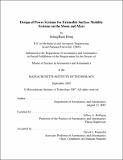Design of power systems for extensible surface mobility systems on the Moon and Mars
Author(s)
Hong, SeungBum, S.M. Massachusetts Institute of Technology
DownloadFull printable version (1.086Mb)
Alternative title
Power system selection program
Other Contributors
Massachusetts Institute of Technology. Dept. of Aeronautics and Astronautics.
Advisor
Jeffrey A. Hoffman.
Terms of use
Metadata
Show full item recordAbstract
This thesis presents the power system model description and sample studies for extensible surface mobility systems on the Moon and Mars. The mathematical model of power systems for planetary vehicles was developed in order to estimate power system configuration with given mission parameters and vehicle specifications. The state-of-art power source technologies for space application were used for constructing the model; batteries, fuel cells, and photovoltaic systems were considered in this thesis. The Sequential Quadratic Programming method was used to find the optimal power system configurations based on the concept of a previous MIT study. Several case studies on the Moon and Mars were carried out to show the usefulness of the model and to recommend power system configurations for 7-day off-base exploration missions on the Moon and Mars. For the lunar mission, photovoltaic and fuel cell hybrid power systems were suggested. In addition, vehicles with photovoltaic/fuel cell hybrid systems could be operated without recharging when they were driving in shadowed regions. For the Mars mission, both fuel cell single power systems and photovoltaic/fuel cell hybrid systems were acceptable for short missions of only a few days. However, if long, sustainable missions were considered, photovoltaic/fuel cell hybrid systems were required.
Description
Thesis (S.M.)--Massachusetts Institute of Technology, Dept. of Aeronautics and Astronautics, 2007. This electronic version was submitted by the student author. The certified thesis is available in the Institute Archives and Special Collections. Includes bibliographical references (p. 99-101).
Date issued
2007Department
Massachusetts Institute of Technology. Department of Aeronautics and AstronauticsPublisher
Massachusetts Institute of Technology
Keywords
Aeronautics and Astronautics.
